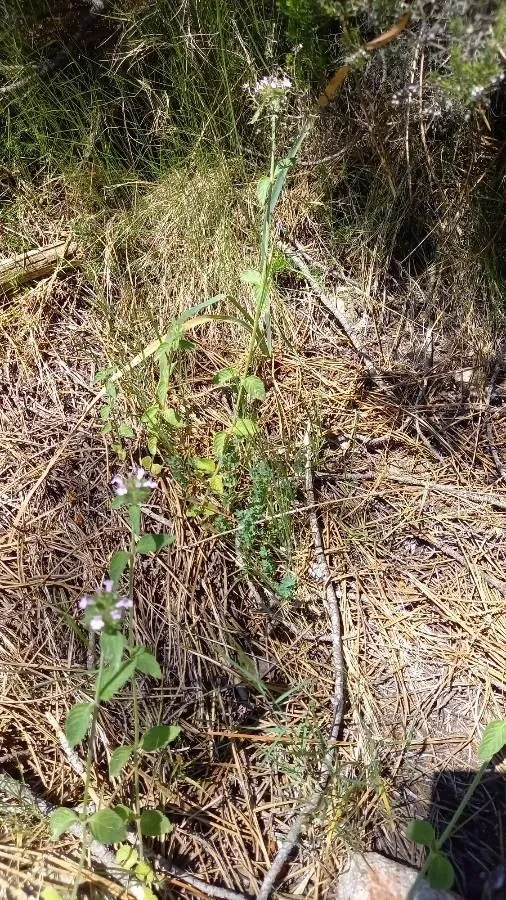
Author: L.
Bibliography: Sp. Pl.: 587 (1753)
Year: 1753
Status: accepted
Rank: species
Genus: Clinopodium
Vegetable: False
Observations: Macaronesia, Medit., Europe to Siberia and W. Himalaya
Cushion calamint, scientifically known as Clinopodium vulgare, is a notable member of the Lamiaceae family. First categorized in 1753 by renowned botanist Carl Linnaeus in his seminal work “Species Plantarum” (page 587), this perennial herb has enthralled botanists and nature enthusiasts alike with its distinctive characteristics and widespread habitat.
This plant thrives across a diverse geographical range, being native to the regions spanning Macaronesia, the Mediterranean, and extending through Europe to Siberia and the Western Himalayas. Its ability to adapt to various climates and soil types has cemented its status as a resilient and hardy species.
C. vulgare typically flourishes in dry, grassy terrains and along forest edges. The plant forms dense, cushion-like clumps, adorned with aromatic leaves and adorned with clusters of small, tubular flowers that vary in color from soft purples to pinks. These flowers not only add aesthetic value but also play a crucial role in supporting local pollinator populations, attracting bees and butterflies with their sweet nectar.
The cushion calamint also holds traditional medicinal value. Historically, its leaves have been utilized in herbal remedies, known for their antispasmodic, diaphoretic, and tonic properties. The aromatic leaves have also been used in culinary practices, where their minty essence adds flavor to various dishes and teas.
In cultivation, Clinopodium vulgare requires minimal maintenance, making it an excellent choice for gardeners seeking to enhance biodiversity. It is best grown in well-drained soils with moderate sunlight and regular pruning to maintain its compact form.
Overall, whether appreciated for its horticultural appeal, ecological benefits, or historical uses, cushion calamint remains a valuable and fascinating species within the vast Lamiaceae family.
Deu: borstige bergminze, wirbeldost, gewöhnlicher wirbeldost
Eng: cushion calamint, dogmint, wild basil
Dan: kransbørste
Swe: bergmynta, bergmynte, værvelmynte, dosta, konig
Nor: bergmynte, værvelmynte
Nld: borstelkrans
Fra: clinopode, sarriette vulgaire
Sme: giegaminta
Cym: brenhinllys clustog, brenhinllys gwyllt, breninllys gwyllt
En: Cushion calamint, Wild basil, Dogmint, Hedge Basil, Hedge Calamint
Ab: Агәыхьхәшә
Ar: رأس العصفور
Be: Вырачка звычайная
Bg: Котешка стъпка
Ca: Clinopodi
Cs: Klinopád obecný
Da: Kransbørste
Nl: Borstelkrans
Et: Harilik mägimünt
Fi: Mäkiminttu, Lehtomäkiminttu
Fr: Calament clinopode, Clinopode, Sarriette vulgaire, Clinopode commun, Grand Basilic, Grand Basilic sauvage, Grand Origan des haies, Pied-de-lit, Roulette, Sariette commune
De: Gewöhnlicher Wirbeldost, Gewöhnlicher Wierbeldost, Wirbeldost, Borstige Bergminze
He: קלינופודיון מנוצה
Ga: Saoisteog
It: Clinopodio dei boschi
Lt: Krūminė šunmėtė
Se: Giegaminta
No: Bergmynte, Værvelmynte
Pl: Klinopodium pospolite
Ru: Пахучка обыкновенная
Sk: Jarva obyčajná
Es: Clinopodio
Sv: Bergmynta, Bergmynte, Værvelmynte, Dosta, Konig
Uk: Пахучка звичайна
Cy: Brenhinllys gwyllt, Brenhinllys Clustog, Breninllys Gwyllt
Taken Dec 7, 2018 by jose (cc-by-sa)
Taken Jul 29, 2018 by Manu Pacha (cc-by-sa)
Taken Jul 13, 2018 by jose (cc-by-sa)
Taken Jul 29, 2018 by Manu Pacha (cc-by-sa)
Taken Dec 7, 2018 by jose (cc-by-sa)
Taken Sep 2, 2021 by 🐞Hélène🐦 (cc-by-sa)
Taken Jul 31, 2021 by Jürgen Kirberg (cc-by-sa)
Taken Oct 11, 2017 by jose (cc-by-sa)
Taken Oct 26, 2017 by Margaret McFarlin (cc-by-sa)
Taken Jul 13, 2018 by Creu Lopez (cc-by-sa)
Taken Jul 23, 2016 by Tela Botanica − Yoan MARTIN (cc-by-sa)
Taken Jul 26, 2022 by Tristan Jaton-Maria (cc-by-sa)
Taken Sep 2, 2021 by 🐞Hélène🐦 (cc-by-sa)
Taken Jun 8, 2022 by Gaël Covain (cc-by-sa)
Taken Jul 1, 2018 by jose (cc-by-sa)
Taken Jan 8, 2022 by rafaela marques (cc-by-sa)
Taken Jun 16, 2021 by Nathalie Potel (cc-by-sa)
Taken Jul 21, 2021 by David Hocken (cc-by-sa)
Taken Sep 23, 2021 by Philippe Bissières (cc-by-sa)
Taken Jun 8, 2022 by Gaël Covain (cc-by-sa)
Taken Nov 15, 2021 by Andres Kruus (cc-by-sa)
Taken Oct 17, 2021 by Frédéric Faure (cc-by-sa)
Taken Sep 3, 2020 by David Hocken (cc-by-sa)
Taken Aug 13, 2021 by Asuan (cc-by-sa)
Taken Sep 2, 2021 by 🐞Hélène🐦 (cc-by-sa)
Taken Oct 26, 2014 by Tela Botanica − Gérard LEVESLIN (cc-by-sa)
Taken Aug 17, 2014 by Tela Botanica − Liliane Roubaudi (cc-by-sa)
Taken Aug 17, 2014 by Tela Botanica − Liliane Roubaudi (cc-by-sa)
Taken Oct 26, 2022 by Francois Mansour (cc-by-sa)
Taken Jul 1, 2022 by Gaël Herve (cc-by-sa)
© copyright of the Board of Trustees of the Royal Botanic Gardens, Kew.
© copyright of the Board of Trustees of the Royal Botanic Gardens, Kew.
© copyright of the Board of Trustees of the Royal Botanic Gardens, Kew.
Growth habit: Forb/herb
Ph maximum: 7.5
Ph minimum: 7.0
Light: 6
Atmospheric humidity: 5
Bloom months: [‘jul’, ‘aug’, ‘sep’]
Soil nutriments: 4
Family: Myrtaceae Author: (F.Muell.) K.D.Hill & L.A.S.Johnson Bibliography: Telopea 6: 402 (1995) Year: 1995 Status:…
Family: Rubiaceae Author: Pierre ex A.Froehner Bibliography: Notizbl. Bot. Gart. Berlin-Dahlem 1: 237 (1897) Year:…
Family: Sapindaceae Author: Koidz. Bibliography: J. Coll. Sci. Imp. Univ. Tokyo 32(1): 38 (1911) Year:…
Family: Asteraceae Author: A.Gray Bibliography: Pacif. Railr. Rep.: 107 (1857) Year: 1857 Status: accepted Rank:…
Family: Fabaceae Author: Medik. Bibliography: Vorles. Churpfälz. Phys.-Ökon. Ges. 2: 398 (1787) Year: 1787 Status:…
Family: Aspleniaceae Author: (Cav.) Alston Bibliography: Bull. Misc. Inform. Kew 1932: 309 (1932) Year: 1932…